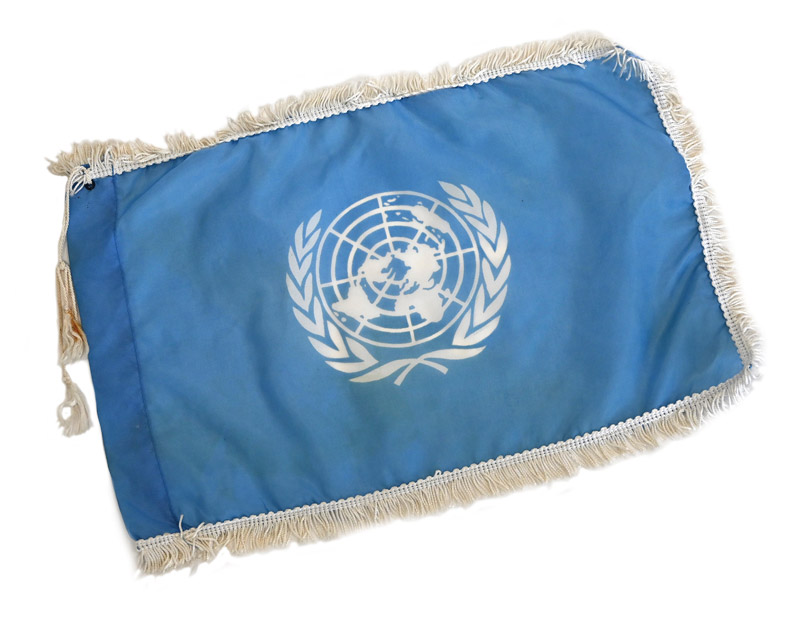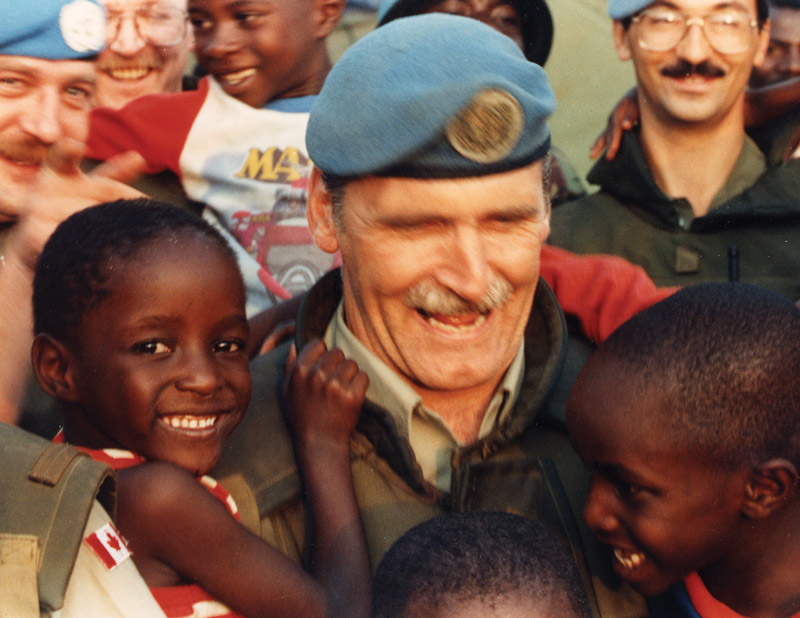
This pennon flew on Lieutenant-General Roméo Dallaire’s truck during his 1990’s United Nations mission to Rwanda.[CJB-L.Benoist]

It’s now part of Juno Beach Centre’s “Faces of Canada Today” exhibit. [CJB-L.Benoist]
The Juno Beach Centre in Courseulles-sur-Mer, France, welcomed an important addition to its “Faces of Canada Today” exhibit recently: the pennon used by Lieutenant-General Roméo Dallaire during his 1990s United Nations mission in Rwanda. Attached to his truck for the duration of the operation, the flag is a poignant example of the Canadian Armed Forces’ dedication to peace, a concept that matters now as much as ever as violence and conflict increase again around the world.
“Peacekeeping missions are more difficult to accomplish,” Dallaire told Legion Magazine. “We took casualties on the ground, but we also had many more casualties of the mind.”
Dallaire was born shortly after the Second World War in Denekamp, Netherlands, to a Canadian soldier and his Dutch war bride. He moved to Canada at six months old and grew up in Montreal. Dallaire joined the army in 1963, then attended the Royal Military College of Canada in Kingston, Ont., graduating in 1970. He rose through the ranks to brigadier-general by 1989. Despite his decades of military experience, however, Dallaire later told the CBC he left “a large part of [his] soul” in Rwanda.
By 1993, Rwanda was consumed by civil war between the country’s Tutsi and Hutu ethnic groups. The UN had first arrived to monitor the border with Uganda after Tutsi extremists known as the Rwandan Patriotic Front invaded Uganda. The Ugandan president called on the UN to help prevent reinforcements from joining the radicals during negotiations to address the incursion, but the force it sent was modest at best.
Dallaire was appointed force commander and supported by one Canadian officer and 81 unarmed military observers. And while the mission had an authorized strength of nearly 2,600 troops, by April 1994 there were just 270 peacekeepers. He often drove in his truck, the UN pennon waving from it, to distract himself from the “limitations put on peacekeepers by the UN regarding intervention and self-defence,” as U.S. Technical Sergeant C. William Strong put it in a 2020 article for American Intelligence Journal.

[Corinne Dufka/courtesy Roméo Dallaire]
After warning UN leaders of imminent mass killings of Tutsis by Hutu extremists, Dallaire’s request to use the force to prevent the impending violence was refused. Dallaire disobeyed a subsequent command to withdraw in the hopes of protecting those his forces could, but still up to 800,000 Tutsis and moderate Hutus were brutally murdered, many by children recruited by the extremists. Dallaire’s flag is seen by some as a heart-rending symbol of the mission’s catastrophic failure.
“I still say a large part of my soul is in Rwanda.”
—Retired general Roméo Dallaire
BY THE NUMBERS
46×32
Size in centimetres of Dallaire’s Rwandan mission pennon
10
Length in months of Dallaire’s command in Rwanda
5,000
Estimated number of child soldiers in Rwanda during the 1994 genocide
37
Years Dallaire served in the Canadian Armed Forces
“I’ve been under 20 years, nearly, of therapy,” Dallaire told CBC on the 25th anniversary of his Rwandan mission. “They have tried, by every means possible to take away my guilt.” His debilitating moral injuries have resulted in four suicide attempts. Finding a way to “master a desire to live,” Dallaire is now the author of four non-fiction books and a humanitarian. He established the Child Soldiers Initiative in 2007, which became the Dallaire Institute for Children, Peace, and Security in 2020. Dallaire also served as a senator from 2005-2014.
“I hope the flag’s perceived as a reference,” said Dallaire of his memento that’s now in the collection of Canada’s Second World War museum in France, “that Canadians should be given the opportunity to sustain peace.”
Advertisement





















